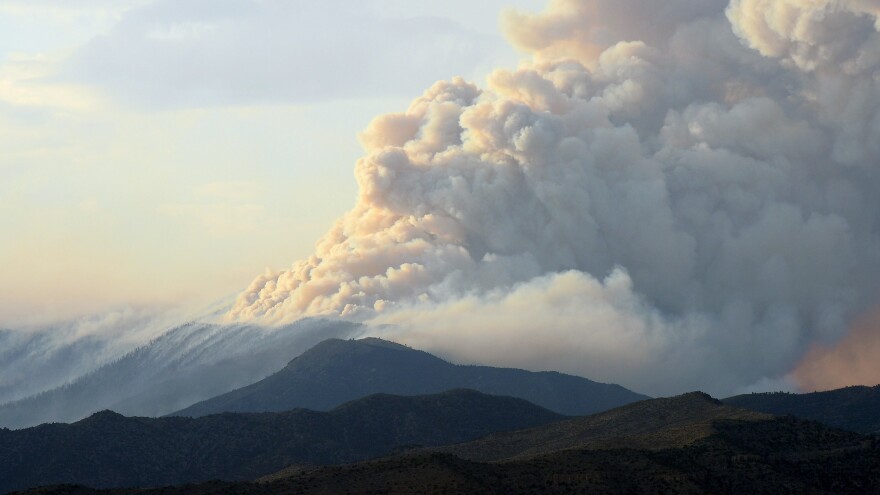A big wildfire in a mountain range just west of Las Vegas has put at risk the Mount Charleston blue butterfly, a rare species found in the U.S.
The fire is dying down, but it may be weeks before experts can get to the remarkable area where this butterfly lives to see if it made it through.
You have a species that has evolved to be dependent on fire that may be exterminated by fire.
There are few examples of fires wiping a species off the planet. In fact, fires sometimes help rare animals and plants by clearing overgrown habitat. But experts fear that such extinctions could become a consequence of two factors that are making some endangered species increasingly vulnerable: the loss of habitat and climate change.
The Mount Charleston blue butterfly, a tiny insect about the size of a quarter, is found in a couple small patches high in southern Nevada's Spring Mountains. These mountains are known as a sky island ecosystem because its relatively cool and wet climate provides homes to a much greater diversity of animals and plants than the arid lands that surround it.
"This mountain island in the middle of the desert [has] been isolated for the last 10,000 years," says Corey Kallstrom, an endangered species expert for the U.S. Fish and Wildlife Service. "Because of that isolation, unique species have developed in that area."
The Mount Charleston blue butterfly is found nowhere else on earth. A large wildfire that's burned through the region for most of this month came close to the main area where this tiny butterfly has been spotted in recent years, according to Kallstrom, and he's worried about their fate.
"I'm hopeful that there have been some that have survived," he says.

The butterfly's key habitat is in rugged terrain that's a several-hours hike up into the mountains. Kallstrom has been trained in forest fire safety, but even he's not allowed in to check on the butterfly — yet.
"It's too unsafe to put anyone up there on the ground to look," he says. "We'll just have to wait and see when we get up there."
Ironically, the Mount Charleston blue butterfly is dependent on wildfires. For thousands of years, fire cleared out the trees and opened up habitat for the small plants that the butterfly feeds on. But for several decades, people have been fighting fires here and elsewhere in the West. The plants the butterfly needs can't grow in forests.
"It's decades of fire suppression in the Mount Charleston area that have caused the trees to overgrow in places where this butterfly used to occur, which has boxed it into a few canyons where it's still hanging on," says Dan Rubinoff, professor of entomology at the University of Hawaii.
Rubinoff, who has been following the Mount Charleston blue's story from afar, called it a "sad irony."
"You have a species that has evolved to be dependent on fire that may be exterminated by fire," he says.
But Rubinoff says this story could end in a happier way. If the butterfly survives, it could have more habitat available.
"If this fire didn't wipe out the butterfly, the fire will actually provide a lot more habitat for the milk vetch that the butterfly needs in the future," Rubinoff says. "So if the butterfly is still around, that fire might end up being a net gain for the butterfly."
The U.S. Fish and Wildlife Service says in the past, fires have benefited endangered plants, fish and insects by restoring habitat that had been overgrown with invasive species or because of fire suppression.
A spokeswoman for the agency says it couldn't come up with any species that have gone extinct because of fires.
But there was a bird that lived on an island off California, the Santa Barbara song sparrow, which was never seen again after an intense fire in 1959. The federal government now considers it extinct.
Like that of the Mount Charleston blue butterfly, much of the Santa Barbara song sparrow's historic habitat had already been eliminated. Experts like Rubinoff say habitat reduction is one reason we may start to hear about species going extinct due to wildfires.
"I think that's going to be something that comes more and more now as species ranges are restricted more and more," Rubinoff says.
Another reason species may be more vulnerable to extinction is climate change. It is making wildfires more common or intense. It's also putting other stresses on rare native animals and plants, such as increasing droughts and invasive plants and pests.
Isolated animals, like the Mount Charleston blue butterfly, are especially vulnerable because they may not be able to flee their range. Rubinoff sees them as the canaries in a coal mine. They show the risks global warming will present to many other species in the future.
"This butterfly is telling us that things are changing in a way they have not changed before," Rubinoff says. "And if we can save things like the Mount Charleston blue, in the process of saving them, we may be saving ourselves."
Copyright 2021 NPR. To see more, visit https://www.npr.org.



